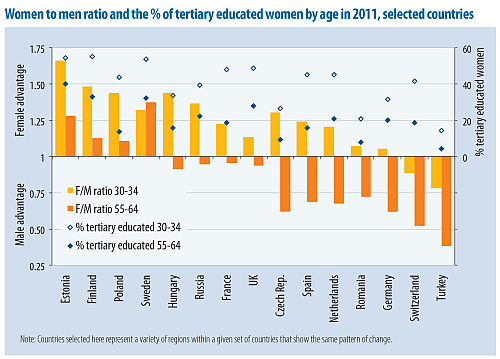Tertiary Education
Female advantage and the reversed gender gap in tertiary education in Europe
Source: http://cf.datawrapper.de/i4e7g/2/
Young generations of Europeans are much better educated than their predecessors, with more than 30% attaining tertiary degrees. A remarkable feature of this educational expansion is the emerging female educational advantage: highly educated women now outnumber men in most countries. Women dominate among the students enrolled in tertiary education (EUROSTAT 2013) and this is also true for the young cohorts entering the labour force. Among 30–34 year olds, the proportion of tertiary-educated women is higher than the proportion of tertiary-educated men in all but three European countries—Luxembourg, Switzerland and Turkey (see the map). Only in Switzerland, Turkey and Cyprus are there more male than female students enrolled in tertiary education (EUROSTAT 2013), so the gap is expected to persist in the coming years.
The map shows the (im)balance in the proportion of tertiary-educated women in 2011, as expressed by the female/male ratio in the share of tertiary-educated. The ratio equal to 1 means gender balance; when it falls below 1 it indicates male advantage and when it climbs above 1 it signals female advantage. A value equal to 2 signals that the proportion of tertiary-educated women is double the proportion of men. Latvia is a clear outlier with a ratio of 1.88. A pronounced gender gap is typical for a string of countries spanning from the North to the South, including the Baltic countries, Poland, Hungary, Italy, and, further away, Portugal (see the map above). A balanced ratio is achieved in only a handful of countries, such as Germany and Austria. Female advantage is clearly linked to the field of studies, with women dominating in teaching, health, humanities and social sciences (including the law and economics) while men make up a majority among those holding degrees in maths, science or engineering (EUROSTAT 2013). The proportion of female students has not been increasing in the latter three fields. This suggests that gender balance might be expected in economies with a strong orientation on hard sciences, especially dealing with new technologies and engineering, such as Austria and Germany. Cultural norms certainly play a role, too. In Turkey, the male advantage in tertiary education persists and the proportion of tertiary-educated women remains low (see the figure below). Only in two quite traditional societies, Kosovo and Bosnia-Herzegovina, are the proportions of tertiary-educated women even lower.

Gains in the proportion of tertiary-educated women are remarkable and become obvious in the comparison of women aged 55–64 and 30–34, i.e. roughly the generations of the mothers and their daughters. Women have benefited most from the expansion of tertiary education and, as a result, the gender gap in tertiary education has closed and even reversed in most countries. Among the 55–64 year olds, in 24 out of 40 countries the male advantage was pronounced (female to male ratio lower than 0.9) whereas tertiary-educated women clearly outnumbered men in only eight countries (ratios above 1.1, mostly Baltic countries, Nordic countries and former state-socialist countries). The situation is reversed for the 30–34 year olds, with only seven countries having balanced ratios or male advantages and 29 countries with a clear domination of women among the tertiary educated (ratios of 1.2 and higher).
Comparing the two age groups, we can split the countries into five groups: in the countries with a female advantage among the 55–64 year olds, the gender gap increased further among the 30–34 year olds and became strongly pronounced with about half as many women with tertiary degree as men [represented by Estonia, Bulgaria, Finland and Poland]. Sweden was the exception and the only country where the female advantage was slightly reduced [see Figure]. In six countries, a slight male advantage among the 55–64 year olds turned into a clear female advantage among the young [group 2 represented by Hungary, Russia, France and the UK] and in an additional 13 countries a pronounced male advantage turned into clear female advantage [Czech republic, Spain and the Netherlands]. A pronounced male advantage turned to a more balanced ratio in only four countries [Germany, Austria, Romania and Malta] and a male advantage persists in three countries.
The structure of education systems, policy targets—such as the EU-wide benchmark of at least 40% tertiary-educated in 2020 among the 30–34 year olds (EUROSTAT 2013)—and service-oriented economies certainly contribute to this new imbalance.
References:
EUROSTAT 2013. European social statistics 2013 edition. Luxembourg: Publication Office of the European Union.